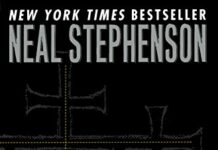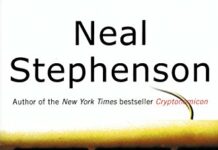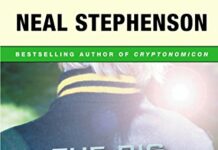
Ebook Info
- Published: 2012
- Number of pages: 481 pages
- Format: Epub
- File Size: 3.32 MB
- Authors: Neal Stephenson
Description
Neal Stephenson follows his international bestseller, the WWII thriller Cryptonomicon, with a novel set in the 16th and 17th centuries, in a world of war, scientific, religious and political turmoil.
With a cast of characters that includes Newton, Leibniz, Christopher Wren, Charles II, Cromwell and the young Benjamin Franklin, Stephenson again shows his extraordinary ability to get inside a place and time; as he did for the futures of his science fiction (Snowcrash,The Diamond Age) and for WWII (Cryptonomicon), here he does for the England of the Civil War and the Europe of the Wars of Religion and the Scientific Revolution. Quicksilver is yet another tour-de-force from a writer who is simply unique.
User’s Reviews
Review “Genius . . . You’ll wish it were longer.” — Time magazine“[QUICKSILVER] explores the philosophical concerns of today . . . through thrillingly clever, suspenseful and amusing plot twists.” — New York Times Book Review“Sprawling, irreverent, and ultimately profound.” — Newsweek“A sprawling, engrossing tale.” — Seattle Times“Stephenson’s new machine is a wonderment to behold. A-” — Entertainment Weekly“An astonishing achievement.” — Sunday Telegraph“[QUICKSILVER] is a rare thing: a 1,000-page book that you don’t want to end. — San Antonio Express-News“[O]ften brilliant and occassionally astonishing …[QUICKSILVER] has wit, ambition and … moments of real genius.” — Book World“[A]n awe-inspiring book, stuffed with heart-stopping action scenes … and a treasure trove of forgotten historical lore.” — Book“Dense, witty, erudite … and gripping … a far more impressive literary endeavor than most so-called “serious” fiction.” — Independent –This text refers to the paperback edition. Amazon.com Review In Quicksilver, the first volume of the “Baroque Cycle,” Neal Stephenson launches his most ambitious work to date. The novel, divided into three books, opens in 1713 with the ageless Enoch Root seeking Daniel Waterhouse on the campus of what passes for MIT in eighteenth-century Massachusetts. Daniel, Enoch’s message conveys, is key to resolving an explosive scientific battle of preeminence between Isaac Newton and Gottfried Wilhelm Leibniz over the development of calculus. As Daniel returns to London aboard the Minerva, readers are catapulted back half a century to recall his years at Cambridge with young Isaac. Daniel is a perfect historical witness. Privy to Robert Hooke’s early drawings of microscope images and with associates among the English nobility, religious radicals, and the Royal Society, he also befriends Samuel Pepys, risks a cup of coffee, and enjoys a lecture on Belgian waffles and cleavage-all before the year 1700. In the second book, Stephenson introduces Jack Shaftoe and Eliza. “Half-Cocked” Jack (also know as the “King of the Vagabonds”) recovers the English Eliza from a Turkish harem. Fleeing the siege of Vienna, the two journey across Europe driven by Eliza’s lust for fame, fortune, and nobility. Gradually, their circle intertwines with that of Daniel in the third book of the novel. The book courses with Stephenson’s scholarship but is rarely bogged down in its historical detail. Stephenson is especially impressive in his ability to represent dialogue over the evolving worldview of seventeenth-century scientists and enliven the most abstruse explanation of theory. Though replete with science, the novel is as much about the complex struggles for political ascendancy and the workings of financial markets. Further, the novel’s literary ambitions match its physical size. Stephenson narrates through epistolary chapters, fragments of plays and poems, journal entries, maps, drawings, genealogic tables, and copious contemporary epigrams. But, caught in this richness, the prose is occasionally neglected and wants editing. Further, anticipating a cycle, the book does not provide a satisfying conclusion to its 900 pages. These are minor quibbles, though. Stephenson has matched ambition to execution, and his faithful, durable readers will be both entertained and richly rewarded with a practicum in Baroque science, cypher, culture, and politics. –Patrick O’Kelley –This text refers to an alternate kindle_edition edition.
Reviews from Amazon users, collected at the time the book is getting published on UniedVRG. It can be related to shiping or paper quality instead of the book content:
⭐ This is a long book and, as usual with Stephenson books, you need patience at the beginning to grasp what is going on. Several interrelated plots take place in Europe and Massachusetts between the years of 1650 and 1715. The reader gets an inside look at the plots and intrigues of the royal families in England, France and Dutch kingdoms while getting also a fascinating look at the quest for knowledge that famous members of the Royal Society (Hooke, Boyle, Huygens, Leibniz, et al) pursued in those years, performing sometimes weird experiments fueled by their ignorance while discovering some of the laws of physics through clear genius and perseverance. The author portrays Isaac Newton as a dark person, heavily involved in Alchemy, a loner , although a genius , and suggest that Hooke came out first with an insight of the gravitational theory. The rivalry between Newton and Leibniz plays a significant part in the plot (both developed Calculus at about the same time in different places). It’s an extraordinary history of historical fiction. And it’s a trilogy if you’re a true fan.
⭐ Quicksilver is the first volume in a really, really long historical novel about the creation of modern science, modern commerce, modern politics and the enlightenment. It is written in an arch, faux 17th century voice (similar to the one used by John Barth in his classic “The Sot Weed Factor.” Reading it will take you a lot of time, no matter how quickly you read! So, should you invest your hard earned minutes of leisure bedding down with Neal Stephenson’s Baroque Cycle? (I’ll cut to the chase – I loved it so much that I read the entire series twice)Do you like adventure stories about piracy?Ever wonder about the plague, the London fire of 1666, and the debauchery of the Restoration?Do you like stories about counterfeiting? How about ones starring Isaac Newton as a master of disguise?Do you like crazed conspiracy tales filled with bodice ripping, massive amounts of gold, the King of France, and a man with bizarrely mutilated genitalia?Do you care about the philosophy of science, but also enjoy really ridiculous puns based on imaginary languages?Do you like harem girls who turn into world-straddling giants of commerce?Did you enjoy Cryptonomicon, and wonder what the ancestors of those characters might have been like?Have you ever wondered about whether the big fight about “who invented calculus” actually may have been really important?Do you like reading about the people who created the modern world?Did you ever wonder whether Leibniz might have been the most important thinker in the history of mankind?Then, you should read this book. Actually, if you love a ripping yarn that (incidentally, mind you) teaches you all about the above mentioned things, then you should read Quicksilver (and its sequels, which are even better). Highly recommended for the self-selecting people who probably realize that they should read it.
⭐ I’ve read two Neil Stephenson books before, Cryptonomicon, which I loved, and Seveneves, which I liked a lot. But this Quicksilver book just left me baffled. I think I got maybe half way through before calling it quits, and even that involved some serious speed reading. The premise was kind of intriguing – mostly following the character Daniel Waterhouse, as he encounters the natural philosophers of the day, mostly noticeably Issac Newton. It was clear Stephenson did some serious historic and cultural research for this book, so I feel bad giving it for me a negative review. Maybe I just simply lack the appropriate attention span, but while each page was kind of interesting on it’s own, I just didn’t know what I was supposed to be taking from this novel, or where it was heading. The was never an issue with Cryptonomicon or Seveneves. I should mention that this is really 3 books stuck together, with numbers 1&3 sharing the same lead character, so it’s truly a brick of a book. I bought this book because I really liked the author, and Amazon was offering it for only 2 bucks. Now I see why.
⭐ This is the second Neal Stephenson book I have read. I had once started Snow Crash but didn’t care for it. I bought Seveneves last year on a $1.99 Kindle Daily Deal just in case, and since it’s sci-fi I gave it a try a couple weeks ago. I couldn’t put it down and now I’ve finished Quicksilver this morning and am well started on The Confusion. That’s how good I think Neal Stephenson is. I’m not getting his description of The Baroque Cycle as sci-fi yet, but I’ve got two big books yet to go. Thank goodness.The funny thing is, I don’t care at all for dialogue and exposition. I’m an action fan in sci-fi and epic fantasy. But I’m finding myself hurrying through the action parts of Quicksilver and settling in again when the dialogues start up once more. His characterizations are brilliant.
⭐ Neal Stephenson is clearly a very good writer and a diligent researcher. He must also be a great typist, because his books have an prodigious spawn of words in them.Good writing partly mitigates that problem. The good writing also distracts you from the fact the books has no plot.I read “Cryptonomicon” right before this. “Cryptonomicon” started out excitingly, making you think it was going to be about cryptography and/or math, both interesting subjects. But then it all wandered away, and the good stuff petered out into the characters roaming around doing not much of anything productive. I guess the publisher was screaming for the manuscript, because finally in the last chapter a sudden decision seems to have been made that the whole lengthy book was about a kind of treasure hunt.The current novel has all the wandering around, crazy time shifts, many characters (enough you forget who’s who, especially over the time jumps) — but it doesn’t even have the nods to interesting subjects (math and crypto in “Cryptonomicon”). Yes, the book promises it’s going to be about Isaac Newton, but he appears only in a bit role.Very disappointing. And the guy is such a good *writer*, too.
⭐ Neal Stephenson’s “Quicksilver” (2003)Three books. “Quicksilver”; “King of the Vagabonds”; “Odalisque” .A masterful, richly detailed & imaginative, re-telling of the lives, times, & circumstances of the historical figures of Newton, Leibniz, and Hooke.An epic narrative with complex fictional characters.Daniel Waterhouse is the central fictional character whose life and experiences convey vivdly the scientific, philosophical, and technological advances of his time, as well as the political and religious turmoil of the 17th century.
⭐ It is not like other books where there are plots and subplots and you learn about culture, politics, and science throughout the story. Those are complex, thought provoking, educational, and enjoyable to me when I’m ready to deal with a complex story.This tale was more like everyday life, in a sense, where you are exposed to different groups of people and there are some tangential threads to others so you find out about multiple worlds, cultures, philosophies, and scientific thoughts. I did not find I was trying to figure out how a plot would evolve, but rather what would happen next l as if I were reading about several individual histories and seeing how a persons life evolved and learning how people, politics, and philosophies change in how things are expressed but not so much in substance.It was not a “page turner” that I could not put down, but I find I entirely enjoyed it and had to get the next two books of the series. It is as if I found old letters from grandparents I barely knew and had an opportunity to get to know them though their daily correspondence.
⭐ This predecessor to Cryptonomicon features similar chacteristics: multiple plots winding out slowly with resolution as they come together at the end. However, it takes much longer than Cryptonomicon for this to occur, during which time, the reader is often treated to interesting literary walkabouts. At about the time when one of the protagonists was swinging around in the rigging during a sea battle with Barbary Pirates, I jumped ship and skimmed the final 30% of the book. The Baroque Cycle is highly regarded, and one day I may clamber back on board for the reminder of the voyage.
⭐ Neal Stephenson is a master storyteller who never fails to deliver the goods, and Quicksilver is no exception. If you’re familiar with Stephenson’s high-tech adventures (e.g., Cryptonomicon, Snow Crash, Zodiac), or those set in alternate/older times (e.g., Diamond Age), you will find Quicksilver a refreshing take on American, English, and French “history” circa late 1600’s, where technology and reason begin to challenge the status quo (e.g., religion, royalty, etc). Quicksilver is entertaining (to say the least), informative (you’ll probably learn a ton, as I did), and extremely funny in parts — I think Stephenson’s works are really under-rated in this respect. If you’ve read this far, do yourself a favor: read Quicksilver!
⭐ This is sooooo very painful to read! I can usually get through a book this length in a few days but this one is so boring at times I find it difficult to read. I like some of the story lines but others just seem to drone on and on. The historical research is definitely well done but I find the dialogues flat and the way the stories are presented makes it difficult to see how they are connected. I understand this is the first installment in the series but I’m almost to the end of the book and I can’t wait to find something else to read. This is quite disappointing, I’ve liked every book this author has written except this one and I was really hoping I would like this book.
Keywords
Free Download Quicksilver (The Baroque Cycle Book 1) in Epub format
Quicksilver (The Baroque Cycle Book 1) Epub Free Download
Download Quicksilver (The Baroque Cycle Book 1) 2012 Epub Free
Quicksilver (The Baroque Cycle Book 1) 2012 Epub Free Download
Download Quicksilver (The Baroque Cycle Book 1) Epub
Free Download Ebook Quicksilver (The Baroque Cycle Book 1)




